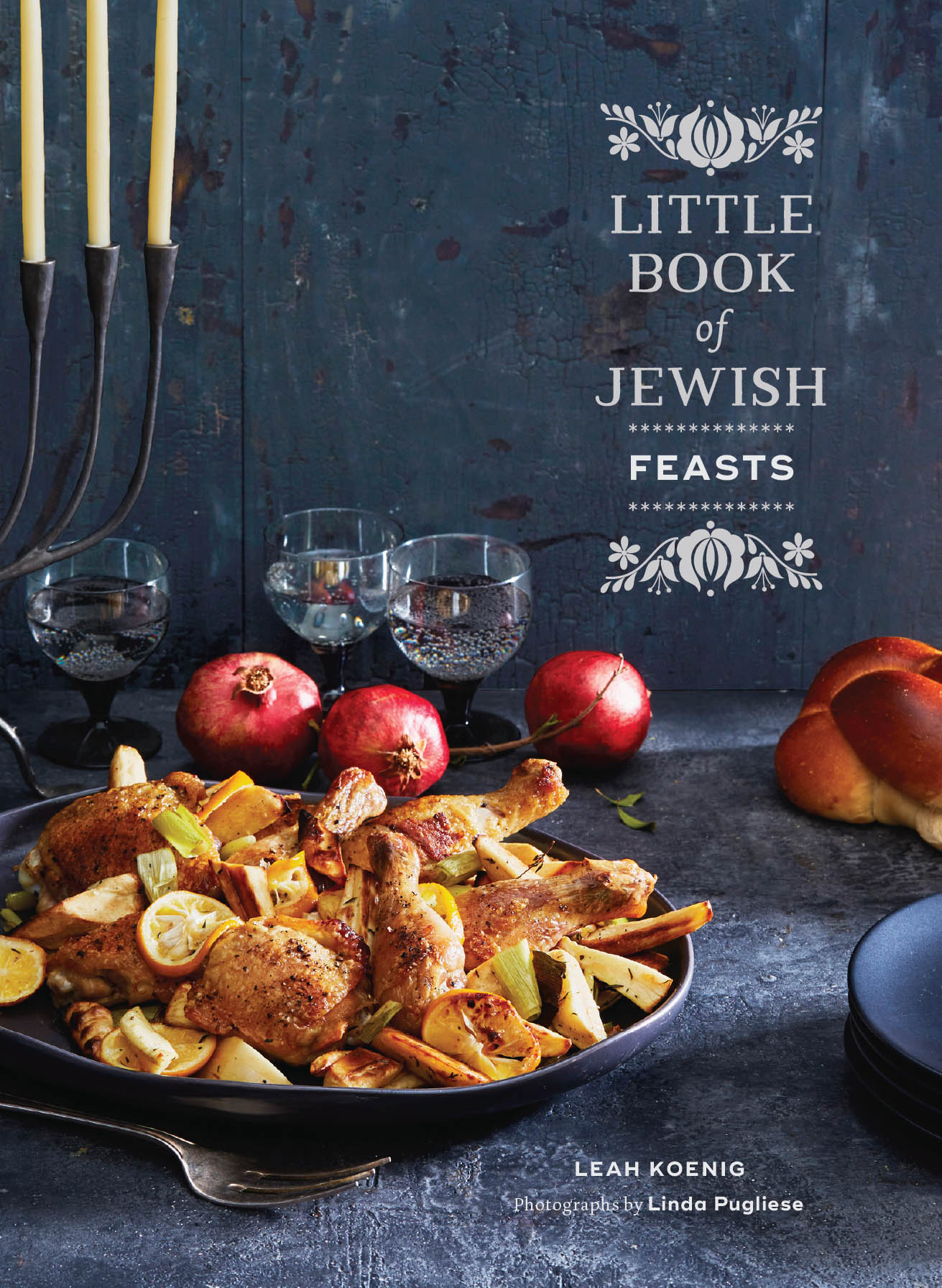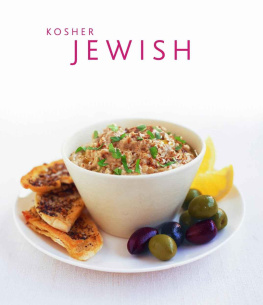


To Carol and Rena, makers of feasts.

**************************
The Little Book series is a collection of thematic Jewish cookbooks that will be published serially. Each book will include a bite-size collection of meticulously curated and category-defining global Jewish recipes. Packaged in slim, gorgeously designed books, a single volumeor the whole serieswill fit perfectly on and enhance an already overcrowded bookshelf.
**************************
ISBN: 978-1-4521-6312-3 (epub, mobi)
Text copyright 2018 by Leah Koenig.
Photographs copyright 2018 by Chronicle Books LLC.
All rights reserved. No part of this book may be reproduced in any form without written permission from the publisher. Library of Congress Cataloging-in-Publication Data available.
ISBN: 978-1-4521-6062-7 (hc)
Designed by Vanessa Dina
Photographs by Linda Pugliese
Food styling by Monica Pierini
Prop styling by Paige Hicks
Typesetting by Frank Brayton
Chronicle books and gifts are available at special quantity discounts to corporations, professional associations, literacy programs, and other organizations. For details and discount information, please contact our corporate/premiums department at or at 1-800-759-0190.
Chronicle Books LLC
680 Second Street
San Francisco, California 94107
www.chroniclebooks.com
INTRODUCTION

Jewish tradition has two houses of worship. The first, of course, is the synagogue, where Jewish communities have joined in prayer and contemplation for generations. The second is the Shabbat and holiday table. It is there, over braided loaves of challah and the bubbling cacophony of laughter and conversation, that memories are made. It is there that families gather and reconnect and heirloom recipes are brought forth to the table like offerings of love and devotion. It is there that traditions are passed downnot through formal instruction, but through the sensory pleasures that come with eating together.
It is no accident that the table has taken on a primary role in Jewish life. When the Holy Temple in Jerusalem was destroyed nearly two thousand years ago, the head rabbis of the era actively shifted many of the central aspects of temple worship and ritual to the home.
The table became the symbolic stand-in for the altarthe place where blessings over wine and bread were said and where candles were lit in place of the glowing menorah that once sat at the heart of the Holy Temple. Meals became much more than just a collection of dishesthey were sacred manifestations of Jewish practice.
It is not surprising, then, that nearly every Jewish holiday has a large meal (or several!) associated with it. On Passover, a feast is sandwiched in between the seders four cups of wine. On Purim day, families sit down for a large, festive meal. On Sukkot, meals are eaten outside in a temporary dwelling structure known as a sukkah. At each holiday, the family around the table, and naturally the food on it, are paramount.
a savory matzo pie with leeks and spinach that Sephardi Jews enjoy.
No matter if its the first time or the hundredth, hosting a Shabbat or holiday meal can be intimidating. In addition to hoping the food tastes good, there are thousands of years and layers upon layers of tradition to uphold and renew. But with family and friends around the table, raising glasses, singing together, and passing serving platters around, all the stress and the prep become worthwhile. This cookbook offers a collection of showstopping main dishes that will delight everyone at the table, including the cook!


********************
Chapter 1
********************
VEGETARIAN AND FISH DISHES

Jewish holiday cooking is traditionally associated with meatand lots of it. But there are plenty of celebratory vegan, vegetarian, and pescatarian dishes to enjoy, especially on holidays like Shavuot, Hanukkah, and Yom Kippur, when dairy meals are more common. From egg- and cheese-laden souffls and butter-crusted savory pies to hearty bean and vegetable stews, this section brings meat-free mains to the center of the table.

Eggplant Kuku (Persian Frittata)
This Persian take on a frittata is packed with bites of creamy sauted eggplant and a bundle of fresh, green herbs. A kuku is rarely out of place on an Iranian-Jewish table. It is usually served as part of the mezze spread or as a side dish, but it is hearty enough to stand alone as a main course, particularly at vegetarian meals. It can often be found at a festive Purim meal, in commemoration of the biblical story of Esther, which took place in ancient Persia. And thanks to the generous amount of oil that goes into a kuku, it is also a favorite dish for Hanukkah celebrations.

SERVES 6
1/3 CUP [80 ML] VEGETABLE OIL, PLUS MORE FOR THE PAN
2 MEDIUM ONIONS, HALVED THROUGH THE ROOT AND THINLY SLICED
KOSHER SALT AND FRESHLY GROUND BLACK PEPPER
1 SMALL EGGPLANT (ABOUT 1 LB [455 G]), PEELED AND CUT INTO 1/2-IN [12-MM] PIECES
7 EGGS
2 TBSP ALL-PURPOSE FLOUR
1 TSP BAKING POWDER
1/2 CUP [25 G] FINELY CHOPPED FRESH FLAT-LEAF PARSLEY
2 TBSP CHOPPED FRESH OREGANO
4 GARLIC CLOVES, MINCED OR PUSHED THROUGH A PRESS
1 TSP GROUND TURMERIC
1 TSP ONION POWDER
1/4 TSP RED PEPPER FLAKES
3 OZ [85 G] FETA, FINELY CRUMBLED (OPTIONAL)
1. Preheat the oven to 375F [190C] and brush a 9-in [23-cm] springform or regular round cake pan with oil. Line the pan with parchment paper (use scissors to cut out a circle of parchment for the bottom and a long strip to wrap around the sides), then brush the parchment lightly with oil.
2. Heat the 1/3 cup [80 ml] oil in a large saut pan over medium heat. Add the onions, season with a little salt, and cook, stirring occasionally, until soft and lightly browned, 8 to 10 minutes. Add the eggplant and continue cooking, stirring occasionally, until softened and lightly browned, about 10 minutes. Remove from the heat and let cool slightly.
3. Meanwhile, whisk together the eggs, flour, baking powder, parsley, oregano, garlic, turmeric, onion powder, red pepper flakes, 3/4 tsp salt, and a generous amount of pepper in a large bowl. Gently fold in the eggplant mixture and feta (if using). Pour into the prepared pan.
4. Bake until golden brown and cooked through, 35 to 40 minutes. Remove from the oven and set aside on a wire rack to cool for 15 minutes. Gently remove from the pan, peel off the parchment, and slice into wedges or squares. Serve warm or at room temperature. Store leftovers, covered, in the fridge for up to 3 days.
Next page













